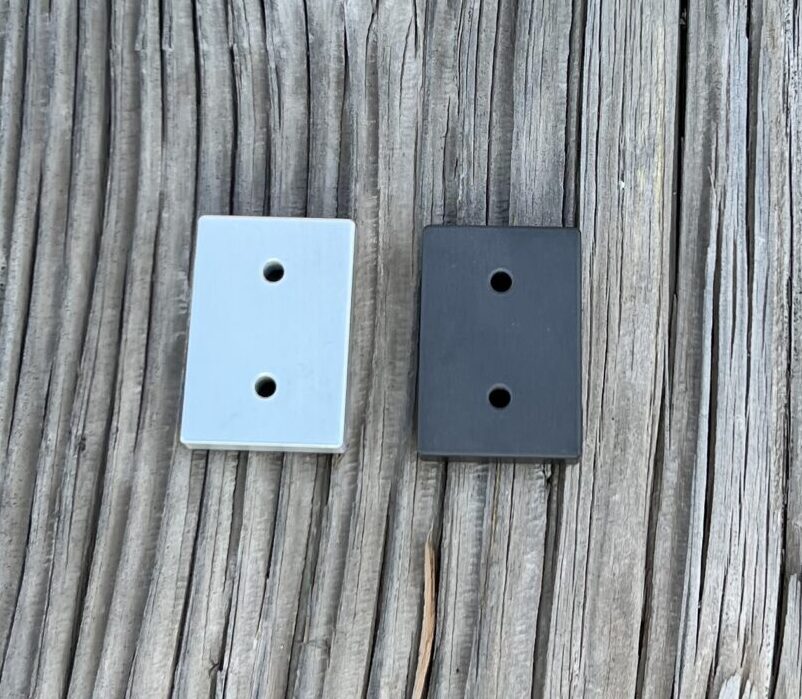TYPE III (HARDCOAT) ANODIZING SERVICES

Before
After
Our high-quality hardcoat aluminum anodizing provides a hard, ceramic-like coating for industrial pieces. Available as a clear coat or in black, the coating penetrates the base metal as much as builds up on the surface. The requested thickness would be the total measurement of the surface buildup and the penetration.
Type III Anodizing Services Available:
Type III Clear (Class I) – MIL-A-8625F
- Compliant with MIL-A-8625F standards. When you need that natural aluminum look with all the benefits, this is your go-to.
Type III Black (Class II) – MIL-A-8625F
- Also adhering to MIL-A-8625F specifications. Black is classic, timeless, and oh-so-functional.
Type III Clear – 7075/2024 (Class I) – MIL-A-8625F
- Because even high-strength aluminum deserves a protective embrace.
Type III Black – 7075/2024 (Class II) – MIL-A-8625F
- When you want the strength of these alloys combined with the ruggedness of hardcoat anodize.
Appearance of Hardcoat Anodize (MIL-A-8625F):
Undyed (Class I):
- The color of the aluminum changes depending on the alloy and anodic thickness. 6xxx-series aluminum tends toward deep gray-black, while 7xxx and 2xxx series appear more bronze-gray.
Dyed (Class II):
- Black is the go-to choice, resulting in a sleek, uniform appearance. Other colors require sampling before production.
Dimensional Impact:
Thickness: .0001 to .004 Inch
- Remember, anodizing is a conversion coating. For Type III anodizing, approximately half of the coating thickness penetrates into the surface, while the other half builds up on the surface. So, for a typical 0.002″ thickness requirement, expect a 0.001″ dimensional change per surface.
Benefits of Type III Anodizing:
Rock-Hard Durability:
Type III anodize laughs in the face of wear and tear. It’s like giving your aluminum armor. Whether it’s industrial machinery, aerospace components, or outdoor gear, this coating can handle it.
Corrosion Resistance:
When sealed, hardcoat anodize becomes your aluminum’s trusty shield against the elements. Rain, humidity, and corrosive substances? No problem.
Electrical Insulation:
The hardcoat coating acts as a dielectric barrier, making it ideal for electrical components. No short circuits here!
Aesthetics:
The color varies based on the alloy and thickness. Deep gray-black for some 6xxx-series aluminum, bronze-gray for 7xxx and 2xxx series. It’s like aluminum couture.
Wear Resistance:
It’s not just a coating; it’s a commitment. Hardcoat anodize stands up to friction, impact, and general roughhousing.
What is Type III (Hardcoat) Anodizing?
Hardcoat Anodize involves creating a dense anodic coating of aluminum oxide on properly cleaned and deoxidized aluminum alloy parts. The process is akin to giving your aluminum components a protective exoskeleton. Here’s the lowdown:
- Electrochemical Magic: The aluminum component takes a dip in a suitable electrolyte (usually sulfuric acid) and faces high voltages (think 100 volts or more). The result? A tougher, denser, and more abrasion-resistant coating than its anodizing cousins.
- Thickness Matters: Type III anodizing isn’t shy about its thickness. It ranges from 0.0005″ to 0.0030″ (and sometimes beyond), depending on the specific alloy being anodized.
In addition to anodize, you can add…:
- Bright Dip
- This is a chemical polish to help brighten the anodize.
- PTFE (Teflon) Coating
- This will help the lubricity of the part.
Don’t forget to ask us about masking or stripping of parts, if needed!
